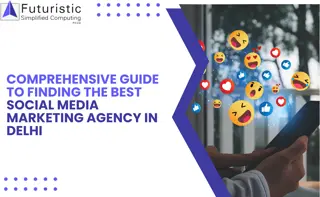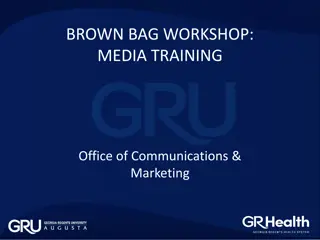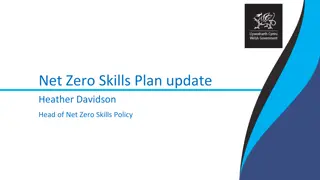Coke Zero Media Plan 2011: Marketing Strategy & Analysis
Coke Zero, a popular zero-calorie soda by Coca-Cola, targets middle to upper-class consumers aged 21-34 living in metro areas. The media plan for 2011 focuses on enhancing brand awareness and market share among this demographic through strategic media objectives and tactics. With a budget of $35 million, the plan aims to capitalize on Coke Zero's success as a preferred low-calorie soda for men while also considering the competitive landscape against brands like Pepsi. Detailed situational analysis, psychographics of the target market, and competitive insights shape the comprehensive marketing strategy for Coke Zero's continued growth.
Download Presentation

Please find below an Image/Link to download the presentation.
The content on the website is provided AS IS for your information and personal use only. It may not be sold, licensed, or shared on other websites without obtaining consent from the author. Download presentation by click this link. If you encounter any issues during the download, it is possible that the publisher has removed the file from their server.
E N D
Presentation Transcript
Coke Zero January 2011-December 2011 Media Plan ARIELLE FRY JARAD KLOOCK KYLIE ETHRIDGE JB3013
Table of Contents 2 Situational Analysis Pg.3 SWOT .Pg.7 Marketing Goals & Media Objectives.................................Pg.9 Media Objectives ..Pg.10 Media Strategies Pg.11 Media Tactics ..Pg.17 Budget Pie Chart Pg.19 Budget Worksheet ...Pg.20 Flowchart ..Pg.21 Plan Performance .Pg.22 Summary Pg.23 Appendix .................................Pg.24
3 Media Budget Situational Analysis $35 Million Product Evaluation Coke Zero is a popular alternative to its parent brand, Coca-Cola. Coke Zero offers an alternate sugar-enhanced taste with the benefit of zero calories, along with the classic Coca-Cola taste to satisfy anyone. Coke Zero is referred to as calorie-free rather than diet to escape the negative connotation that diet is only for women or that diet drinks taste bad. With its zero calories, classic Coca-Cola taste, Coke Zero makes drinking low or no calorie soda attractive to men. Since Coke Zero s launch, it has been one of the best products in Coca-Cola history and has now been made available in 100 countries. Coke Zero s success can also attributed to its parent brand, Coca Cola and its global standing. Coca Cola, which has nearly 500 other brands and has a global standing, is a well-known industry leader when it comes to soft-drinks, fruit juices, sports drinks and many others. Media Budget $35 Million Product Evaluation
4 Psychographics: The consumers in this target market are middle to upper class, ranging between single and married, and usually do not have any children. Most live in metros and urban areas working as white collar workers, many as professionals. With the lack of children, most have a comfortable and flexible lifestyle, with interest in various forms of entertainment, sports and shopping. Also, many live in mid-sized homes, with hopes of becoming a homeowner someday. Situational Analysis: Primary Target Snapshot Geographic: Penetrated Region: South Region for opportunity: West and Midwest Demographics Age: Men21-28; the secondary market would be men and women 25-34 Sex: men and women; predominately men Income: $ 20,000 and up Race: White and Asian Marital Status: Single Education: Graduated college plus more education Usage Habits: 20 percent of adults ages 34-44 drank Coke Zero in the last 6 months. Consumer Profile: John is 27 years old and currently works as a market analyst for a local downtown firm. He graduated college several years ago with a degree and later went on to grad school. Currently John is living in Dallas with his wife, who is a nurse. The couple plans to stay in Dallas, which is where they plan to have children and buy a home. In their free, time John and his wife like to attend sporting events in their city, shop, eat out at restaurants and seek various forms of entertainment.
5 Competitive Analysis The Coca Cola and Pepsi s market share has most to do with region. While the market share is nearly equal, it depends on which country and area you are in. Both brands original sodas have their diet counterparts, so therefore the target market for them is nearly identical. However, Diet Coke has been a prominent force in the realm of diet soda for the longest time. Pepsi and other competing brands such as Pepsi Max, Pepsi One and Diet Dr. Pepper have not been competing for as long as Coke. Therefore, since Coke has had the niche of diet drinkers the longest, it is most likely that Coke drinkers are more inclined to trust their company to create a diet soda than any of Pepsi s brands. This alone gives Coca-Cola a huge advantage in the diet soda department. Situational Analysis Competitive Analysis Pepsi Dr.Pepper Other diet sodas Advertising History Primarily directed toward males Advertising History Coke Zero s past advertising has been primarily directed at males with dark backgrounds, simple layouts, and sexual undertones. In the past, Coke Zero has used internet, TV, and magazines as a medium for their advertisements. They have also used mobile marketing and out-of-home such as product displays in stores.
6 Sales History Since Coke Zero s introduction in 2006, the sales of sugar free Pepsi products including Pepsi Max and Diet Pepsi have dropped from 138 million liters to 129 million liters within a year. With Coke Zero being the biggest launch since Diet Coke 22 years ago, the Coca-Cola Company gained revenue of over 24 million dollars within the first 16 weeks of its introduction. In 2008, Coke Zero s sales had jumped 36% from the 600 million cases sold globally. Figures show that throughout Coke Zero s sales so far, most of the sales have pulled from Coke Classic drinkers rather than Diet Coke drinkers. Situational Analysis Sales History Sales jumped 35%, but pulled mainly from Coke Classic drinkers Product Distribution Product Distribution The Coca Cola and Pepsi market share has most to do with region. While the market share is nearly equal, it depends on which country and area you are in. Both brands original sodas have their diet counterparts, so therefore the target market for them is nearly identical, but slightly different in ways mentioned above. However, Diet Coke has been a prominent force in the realm of diet soda for the longest time. Pepsi has not been competing in that manner for nearly as long as Coke. Since Coke has had the niche of diet drinkers the longest, it is most likely that Coke drinkers are more inclined to trust their company to create a diet soda than any of Pepsi s brands. This alone gives Coca-Cola a huge advantage in the diet soda department. Market share has to do with region
7 Strengths When you drink Coke, you re using a brand that has stood the test of time, and to most consumers appears to be the brand that has the most classic appeal. It also has less aspartame than Diet Coke; therefore, it is a big change from the other diet soft drinks that are available. Due to the lack of aspartame, Coke Zero claims to have less of an aftertaste, which is always desirable for a soft drink consumer. It is sweeter than Diet Coke, but contains less sugar and more of a Coca Cola classic taste than it s diet counterpart. Weaknesses While Coke Zero s image is far from unacceptable, and its appeal is wide amongst men, it bottlenecks itself from being marketable to the other half of the population, women. It might be wise in the future begin to slowly meld the media plan into marketing this product to women as well as men. Another disadvantage is that Coke Zero is also relatively new in the market, so the awareness of its availability is there, but necessarily everyone knows of its benefits and actual taste. SWOT Strengths Weaknesses
8 Threats The threats to Coke Zero include every diet product out there. This includes Diet Pepsi, Pepsi Max, Pepsi One, Diet Dr. Pepper or any diet soda. Many people may try to balance their diets in certain ways unrelated to drinking diet sodas. Many people are dedicated Coke drinkers already. So, it may be that people will eat healthier or eat more low calorie foods, but not supplement their diets with diet products such as Coke Zero. Coke Zero s biggest and most dangerous competitor would easily have to be Pepsi. Pepsi s low calorie and low sugar soda, Pepsi One, is most desirable for Pepsi drinkers who have the same outlook on health. While Coke is slightly more popular than Pepsi, Pepsi still has its groups of loyal brand consumers. Opportunities Coke Zero has an opportunity to expand its market by creating advertisements that are not so obviously male-oriented. The past advertising is directed at males so by creating another set of ads that do not turn off their primary male audience, but are more attractive to the female market, they stand to raise their profits. The main tool they could use in order to achieve this is the zero calories quality of the product. Much of the older audience is concerned with maintaining their figure as they age and by playing on this, Coke Zero can loop this segment into their market as well. SWOT Threats Opportunities
9 Marketing Goals: Increase Sales among men 21-28 years old by 5% within 12 months Increase product awareness to target audience by 15% Geography Advertising will achieve geographic coverage by having a national campaign. We will also maintain national coverage throughout our promotion as well. Reach and Frequency Goals Advertising should focus on frequency rather than reach because of the type of product Coke Zero is. Since soft drinks are products that are purchased daily, consumers need to be frequently reminded of Coke Zero so that they choose this product over their usual choice. With our campaign, we would like to obtain a reach of 60% and a frequency of 5. Marketing Goals and Media Objectives Marketing Goals Increase sales among men 21-28 by 5% Increase product awareness by 15% Geography National Reach and Frequency Reach: 60% Frequency: 5
10 Creative Implications There are no creative implications. Promotional Support Advertising will focus on the Stanley Cup for the promotional event in the months of late March through June. Because Stanley Cup s primary audience matches Coke Zero s target audience, advertising will be heavy up before and during the time that the Stanley Cup is going on. Prior to this, national advertising will promote Coke Zero s sponsoring of the Stanley Cup. Pattern of Scheduling Advertising should be scheduled in a pulsing pattern, where advertising is scheduled continuously throughout the year to continue to gain awareness for the product and to serve as a reminder for consumers. Advertising should also be scheduled with a heavy emphasis during the months of March though June to raise promotional awareness of the 2010 Stanley Cup. Media Objectives Creative Implications No creative implications Promotional Support Stanley Cup Pattern of Scheduling Pulsing
Media Strategies 11 Target Audience cont. Also, to assist the media and vehicles we plan use; we could use radio and internet as an option to increase frequency and for our promotion. Rationale: The vehicles for media listed are just a few that appeal to one or both portions of the target audience and can result in a high reach. If possible or needed, radio and internet would be used to increase frequency especially during the time of the promotion. Target Audience Coke Zero s target audience, an audience of primarily younger males and a secondary audience of females, can be reached through media such as TV, magazine and internet. The best vehicles to target this audience would be TV stations such as ESPN, ABC, Spike and TBS; consumer magazines such as EPSN, Entertainment Weekly, and GQ; and internet Web sites such as foxsports.com, cbs.com, and espn.com.
Media Strategies cont. 12 Geographic Coverage For Coke Zero, we want to gain national coverage through television stations such as ESPN, ESPN 2, Spike, ABC, FOX, TBS, CNBC, CBS, CBS College Sports Network, and Comedy Central. Rationale: These television stations tend have a higher viewing among the Coke Zero primary audience which would be beneficial to maintaining and gaining product awareness. The television stations, ABC, CBS, FOX and TBS are able to reach and appeal to both the primary and secondary audiences as well. Also, to achieve maximum exposure of our ads, we will want to advertise to the primary target audience during primetime, the hours of 11:30pm-1am (such as Adult Swim), bowl games and football-college weekend. Geographic Coverage cont. Along with the national television coverage, we will use magazines in addition to television. Male driven magazines such as ESPN, GQ, Esquire, Maxim will be used. Rationale: By using these magazines in addition to the use of television, we are able secure a better reach of our primary target audience and gain awareness.
Media Strategies cont. 13 Pattern of Scheduling cont. During time of the Stanley Cup, late March-July, we will want to heavy up by increasing internet in respect to our promotion. We also want to heavy up by using television related to promotion as support. Rationale: Because the Stanley Cup is spread out through about 3-4 months, we will need to increase and maintain frequency through popular sports Web sites such as espn.com (especially the NHL Page), CBSsportline.com, foxsports.com, NHL.com, as well as on the sports and NHL pages of websites. Pattern of Scheduling We will maintain a pulsing pattern of advertising throughout the year to gain awareness and to increase sales with an emphasis on the NHL Stanley Cup. We will achieve the yearlong continuity of the campaign through mostly television and magazines. During the fourth quarter, we will not advertise television due to the excessive clutter during the holidays and because of budget constraints.
Media Strategies cont. 14 Reach/Frequency cont. Rationale: During our year-long advertising campaign, we want to not only want to on focus reach but also frequency. We will achieve this through internet Web sites such as, espn.com, msnbc.com, foxsports.com and cbs.com. Specifically during our NHL Stanley Cup promotion, we will use the same Web sites to build frequency and perhaps for extra support, radio would be used. Rationale: Radio is a high frequency medium that could be beneficial to our NHL Stanley Cup promotion. We could achieve this through radio stations focusing on genres such as, sports talk, some news talk, classical rock, alternative rock. Reach/ Frequency We will want to use television and magazines to build reach and awareness of Coke Zero. In addition to building reach, we will also want to build frequency. We will do this mostly during the time of our promotion with the use of internet and radio. Rationale: Television is the best medium to use because it has a high reach factor and our primary target audience and portions of our secondary audience are more likely to tune into television programs such as sports, news, primetime and late night television programs, which appeal to them. We want to build frequency by using the internet as a medium during the time of the NHL Stanley Cup.
Media Strategies cont. 15 Promotional Support cont. Rationale: For television, we will be running advertisements in addition to those already running promoting Coke Zero s sponsoring of the Stanley Cup. These advertisements will run on stations such as ESPN, CNN, MSNBC, and Fox News to reach our target audience. We will also run advertisements on stations such as MTV, VH1, and Comdey Central to reach our primary audience, as well as our secondary audience. Creative Implications There are no creative implications for Coke Zero. Promotional Support We will want to support and maintain our promotion of the NHL Stanley cup through television, internet, and radio to. During the duration of campaign, late March through June, we will want focus our televisions and internet spots on the promotion. We will also heavy up by including some radio to add support to the media already in use and to continue to gain frequency.
Media Strategies cont. 16 Promotional Support cont. Rationale: For internet, we will focus mainly on sports and news Web sites, such as espn.com, nhl.com, cnn.com, and cbs.com in order to effectively reach our target audience. In addition to the advertisements already on these sites, we will place advertisements specifically promoting the Stanley Cup. We also want to make sure we advertise on specific pages, such as the hockey/NHL section on any of the sports sites and pages. Promotional Support cont. Rationale: Radio spots will run on national radio stations such as sports radio, talk radio, classic rock stations, alternative rock, and top 40 stations during the morning or afternoon drive times in order to reach our primary target audience on their way to or from work. Radio advertisements will focus on promoting Coke Zero s sponsoring of the Stanley Cup and to gain frequency for the promotion and campaign.
Media Tactics 17 Magazine: Full Page Ads: 4-color full page with bleed Magazines: ESPN No cover Special Issues: Jan. 11 BCS Preview; April 5 NHL Playoffs; May 3 NBA Playoffs preview, NFL draft preview, June 14 MLB Coverage; June 28 NBA and NHL Draft Preview; Dec. 27 BCS Championship bowls preview Page Ads: 4-color page with bleed No cover Magazines: Maxim and GQ Television: Cable Television: :30 second spots Primetime Channels: ESPN, Spike Affordable GRP: 1200 National Television 30 second spots Late fringe Channels: ABC Affordable GRP: 400
Media Tactics cont. 18 Internet: Banner ad Positioned at the top of the page Websites: www.NHL.com National Radio: : 30 second radio spot Afternoon Drive time National Radio Station: American Top 40 Affordable GRP: 1200 Run of site Websites: www.ESPN.com
Coke Zero Media Budget 19 Total Media Budget 5% 7% Television Magazine Radio Internet 21% 67%
Budget Worksheet 20 Budget Worksheet: Coke Zero Media Planners: Arielle Frye, Jarad Kloock. Kylie Ethridge Market (DMA): National First Qtr Second Qtr Third Qtr Fourth Qtr TOTAL Cable TV: Primetime ESPN GRP CPP 0 400 400 0 800 10239 10239 10239 10239 10239 Cost GRP CPP $0 $4,095,600 $4,095,600 $0 $8,191,200 Cable TV: Primetime Spike 400 0 0 0 400 10239 10239 10239 10239 10239 Cost GRP CPP Cost GRP CPP Cost GRP Frequency Rate Cost GRP Frequency Rate Cost GRP Frequency Rate Cost GRP Frequency CPM Cost GRP Frequency CPM Cost GRP Average CPP $4,095,600 $0 $0 $0 $4,095,600 Network TV: late fringe ABC Network Radio: Afternoon Drive American Top 40 0 400 0 0 400 27775 27775 27775 27775 27775 $0 $11,110,000 $0 $0 $11,110,000 0 1200 1410 0 0 1200 1410 1410 1410 1410 $0 $1,692,000 $0 $0 $1,692,000 162 162 162 162 648 6 6 6 6 6 $183,872 $1,103,232 $183,872 $1,103,232 $183,872 $1,103,232 $183,872 $1,103,232 $183,872 $4,412,928 ESPN Full page 126 126 126 126 504 3 3 3 3 3 $134,030 $402,090 $134,030 $402,090 $134,030 $402,090 $134,030 $402,090 Maxim 1/2 page $1,608,360 63 126 84 63 336 3 6 4 3 4 $80,181 $240,543 $80,181 $481,086 $80,181 $320,724 $80,181 $240,543 $80,181 $1,282,896 GQ 1/2 page 0 0 300 0 0 0 0 300 5 1 $0 $0 0 0 $0 $0 751 $100 $0 $0 100 $0 $0 0 0 $0 $0 351 www.NHL.com $1,801,500 $1,801,500 100 2 1 $50 www.ESPN.com $750,750 $750,750 4288 16084 $34,945,234 2714 16084 872 TOTAL 13141 16084 13141 $0 $0 $5,841,465 $20,685,508 $6,672,396 $1,745,865
Media Scheduling 21 2010 Media Flowchart January February March April May June July August September October November December Cost MEDIA 1 8 15 22 29 5 13 19 26 5 12 19 26 2 9 16 23 30 7 14 21 28 4 11 18 25 2 9 16 23 30 6 13 20 27 3 10 17 24 1 8 15 22 29 5 12 19 26 4 11 18 25 Television Primetime - Espn 100100100100 100 100 100100 $8,191,200 Primetime - Spike 100 100 100100 $4,095,600 Late Fringe - ABC 100100100100 $11,110,000 $23,396,800 Magazine ESPN X X X X X X X X X X X X X X X X X X X X X X X X $4,412,928 GQ X X X XX XX XX XX X X X X X $1,282,896 MAXIM X X X X X X X X X X X X 1,608,360 7,304,184 Radio Afternoon Drive 100100100100100100100100 100 100 100100 1,692,000 $1,692,000 Internet www.NHL.com 60 60 60 60 60 60 60 60 $1,801,500 www.espn.com 50 50 50 50 $750,750 $2,552,250 $34,945,234
Summary 23 Our campaign is bound to increase sales, awareness, and enthusiasm for Coke Zero by the way we have effectively used our budget of $35 million to meet our goals of increasing the sales among men 21-28 years old by 5% within 12 months and also increasing product awareness to the target audience by 15%. Every decision and strategy we ve chosen, from the position of radio and T.V. spots, to the people we ve chosen to market to, was thought out and based off of tangible concepts and thorough research. We ve efficiently segmented the population to mainly market to the target audience of young, professional men with an active lifestyle that will be most likely to purchase Coke Zero. The positioning and timing of our spots meet the target where they are in their daily lives. The most notable advantage we have is how we segmented the population to find our ideal audience, which will produce the largest profit for Coke Zero.
Appendix 24























